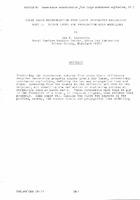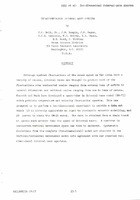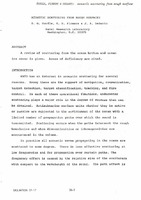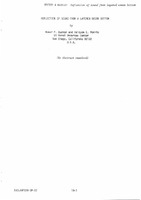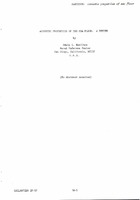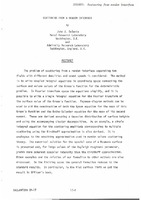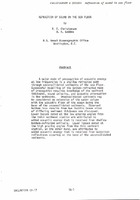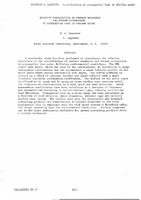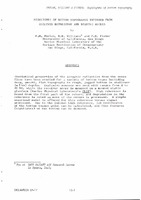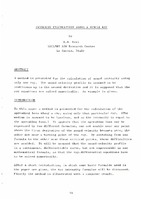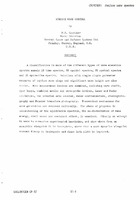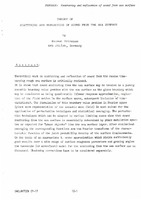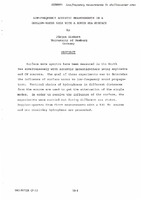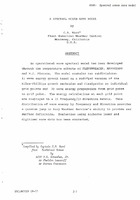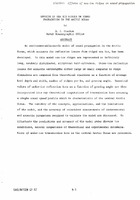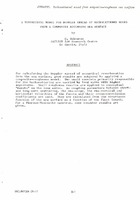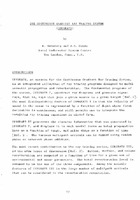Reprints: Recent submissions
Now showing items 141-160 of 548
-
Ocean-basin reverberation from large underwater explosions: part 1: source-level and propagation-loss modelling
(NATO. SACLANTCEN, 1975/10)Predicting the reverberant returns from ocean basin reflectors requires describing acoustic source levels for large, conventional underwater explosions, defining the two way propagation loss and signal spreading from the ... -
Two dimensional internal-wave spectra
(NATO. SACLANTCEN, 1975/10)Although spatial fluctuations of the sound speed in the ocean have a variety of causes, internal waves are thought to produce most of the fluctuations over horizontal scales ranging from several tens of metres to several ... -
Acoustic scintillations of acoustic waves
(NATO. SACLANTCEN, 1975/10) -
Intensity and phase fluctuations in low-frequency acoustic transmission through internal waves
(NATO. SACLANTCEN, 1975/10) -
Acoustic scattering from rough surfaces
(NATO. SACLANTCEN, 1975/10)A review of scattering from the ocean bottom and ocean ice cover is given. Areas of deficiency are cited. -
Reflection of sound from a layered ocean bottom
(NATO. SACLANTCEN, 1975/10) -
Acoustic properties of the sea floor: a review
(NATO. SACLANTCEN, 1975/10) -
Scattering from a random interface
(NATO. SACLANTCEN, 1975/10)The problem of scattering from a random interface separating two fluids with different densities and sound speeds is considered. The method is to write coupled integral equations in coordinate space connecting the surface ... -
Refraction of sound in the sea floor
(NATO. SACLANTCEN, 1975/10)A major mode of propagation of acoustic energy at low frequencies is a shallow refracted path through unconsolidated sediments of the sea floor. Successful modelling of the bottom-refracted mode of propagation requires ... -
Relative contribution of surface roughness and bottom attenuation to propagation loss in shallow water
(NATO. SACLANTCEN, 1975/10)A simulation study has been performed to investigate the relative importance of the contributions of surface roughness and bottom attenuation to propagation loss under differing environmental conditionso The NRL normal ... -
Highlights of bottom topography inferred from received depression and bearing angles
(NATO. SACLANTCEN, 1975/10)Statistical properties of the acoustic reflection from the ocean floor have been studied for a var i.ety of bottom types including deep, smooth, flat topography thorough, jagged bottom in shallower (~l km) depths. Explosive ... -
Intensity calculations along a single ray
(NATO. SACLANTCEN, 1971/12)A method is presented for the calculation of sound intensity using only one ray. The sound velocity profile is assumed to be continuous up to the second derivative and it is supposed that the ray equations are solved ... -
Ocean-bottom reflectivity (a point of view)
(NATO. SACLANTCEN, 1975/10)The analysis procedures for extracting bottom loss values from pulsed acoustic signals that have interacted with the ocean bottom do not inherently consider sub-bottom refraction and reflection of sound, which are important ... -
Surface wave spectra
(NATO. SACLANTCEN, 1975/10)A classification is made of the different types of wave elevation spectra namely lD time spectra, lD spatial spectra, 2D spatial spectra and 3D space-time spectra. Relations with simple single parameter measures of surface ... -
Theory of scattering and reflection of sound from the sea surface
(NATO. SACLANTCEN, 1975/10)Theoretical work on scattering and reflection of sound from the random timevarying rough sea surface is critically reviewed. It is shown that sound scattering from the sea surface may be treated as a purely acoustic boundary ... -
Low-frequency acoustic measurements in a shallow-water area with a rough sea surface
(NATO. SACLANTCEN, 1975/10)Surface wave spectra have been measured in the North Sea simultaneously with acoustic investigations using explosive and CW sources. The goal of these experiments was to determine the influence of surface waves to low-frequency ... -
A spectral ocean wave model
(NATO. SACLANTCEN, 1975/10)An operational wave spectral model has been developed through the cooperative efforts of FLENUMWEACEN, NAVOCEANO and W.J. Pierson. The model contains two subdivisions: 1) wave energy growth based on a modified version of ... -
Effects of sea-ice ridges on sound propagation in the Arctic Ocean
(NATO. SACLANTCEN, 1975/10)An environmental/acoustic model of sound propagation in the Arctic Ocean, which accounts for reflection losses from ridged sea ice, has been developed. In this model sea-ice ridges are represented as infinitely long, ... -
A theoretical model for doppler spread of backscattered sound from a composite roughness sea surface
(NATO. SACLANTCEN, 1975/10)For calculating the Doppler spread of acoustical reverberation from the sea surface, good results are achieved by applying a composite-roughness model. The small wavelets primarily responsible for the backscattering are ... -
The continuous gradient ray tracing system (CONGRATS)
(NATO. SACLANTCEN, 1971/12)CONGRATS, an acronym for the Continuous Gradient Ray Tracing System, is an integrated collection of ray tracing programs designed to model acoustic propagation and reverberation. The fundamental programs of the series, ...
